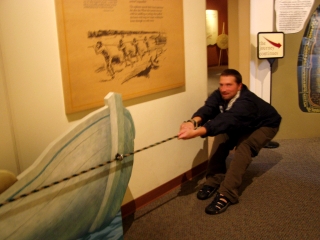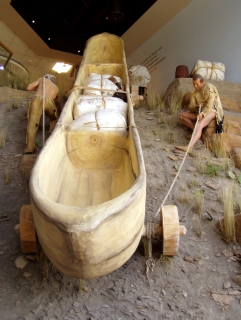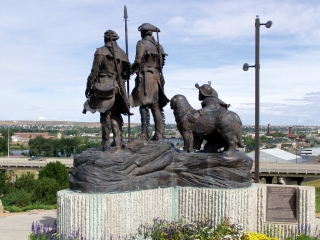United States Forest Service Website; Virtual Tour via Great Falls Tribune
 WHAT IS IT?
WHAT IS IT?5,500 square feet of permanent exhibits that attempt to explain Lewis and Clark’s entire 1804-1806 journey.
BEAUTY (3/10)
The Center’s building is a modern, beautiful use of space. It overlooks the Missouri River, which no longer has Great Falls, and looks nothing like the waterway Lewis and Clark once portaged.
HISTORICAL INTEREST (3/10)
This area proved to be slow going for the Corps of Discovery. The series of falls were difficult to portage, as evidenced by the life-sized scene, spanning two floors in the atrium of the Center. Great Falls is seen as one of the great trials and difficulties of the Lewis and Clark journey.
CROWDS (2/10)
Many travelers make their way to the Lewis and Clark Center in Great Falls. 80,000 per year. There will probably be more during the 2004-2006 bicentennial celebration. We ran into a large, slow-moving and mostly septuagenarian crowd. Much different than our encounters at less remote L&C Sites. No one seemed excited, walking through the exhibits with a visible sense of obligation. “It’s on the trail. We’ve got to do it.”
EASE OF USE/ACCESS (3/5)
The Interpretive Center is aware of its audience. Elevators and ramps are abundant, both inside and outside the building. Easy walking trails line the bank of the Missouri. The site itself is not far from the Interstate but you still need to go through Great Falls to get to it. Anyone at the Great Falls Visitor Information Center, or anyone in Great Falls for that matter, will point you in the right direction. Make a right, then a left, then a right.
 CONCESSIONS/BOOKSTORE (3/5)
CONCESSIONS/BOOKSTORE (3/5)The Bookstore included a terrific selection of Lewis and Clark titles. All of the standards and more but they were all arranged on four spinning towers which, because of the slow-moving crowd, we found impossible to get to. We saw the titles through the bookstore’s glass partitions, never personally handling the books.
COSTS (3/5)
The Site costs $5.00 per person. Because the National Forest Service administers the Site, admission is free with the $15 National Parks Pass Golden Eagle Hologram Sticker Upgrade. The upgrade covers admission to all National Forests and Bureau of Land Management Sites.
RANGER/GUIDE TO TOURIST RATIO (3/5)
On sheer numbers alone, this rating is a 3. Forest Rangers and volunteers were everywhere. If you moved within 10 feet of any of them, you were met with the same recorded mantra: “A (Ranger talk or Ken Burns) film begins in (fill-in-blank) minutes in the (fill-in-blank) room. You should go see it. It’s really good”
The aforesaid Ranger talks occurred every hour and we would have attended another had we even slightly enjoyed the first. If you want the Stephen Ambrose/Ken Burns doctrine explained then the Rangers will be helpful.
TOURS/CLASSES (2/10)
The Center stresses that you first watch the 30-minute introductory film, Corps of Discovery, filmed, directed and narrated by the ubiquitous Ken Burns. We found the film to be too long, too boring, and at times historically suspect. It is only recut snippets of Burns’ marathon 1997 Lewis and Clark – Corps of Discovery documentary. If you have already seen that film, do not waste another half hour.
The film stated as fact many topics that we have learned at other L&C Sites to be subjects of intense historical debate. For example, was Sakakawea kidnapped or born Hidatsa? The Lewis and Clark Journals state that she embraced a Shoshone chief and called him “Brother.” From this interaction, the non-native explorers concluded that this was her “real” family from whom she had been separated.
At Knife River Villages NHS, more than this singular interpretation is offered. Knife River Villages, home of Sakakawea and her alleged kidnappers, was traditionally a great center of commerce. Trading partners from numerous and even enemy tribes would congregate at markets and celebrations here, much like the fur trade’s Rendezvous at various forts. A Lewis and Clark historian at Knife River explained to us that it was very possible that Sakakawea knew the Shoshone chief from these commercial interactions. Her use of the word “brother” and her reported joy at seeing him does not necessarily lead to the same conclusions that are noted in the journals and stated as irrefutable fact in the Ken Burns film.
 The museum is a carbon copy of the film. Well produced, beautifully designed but lifeless, overly concerned with prose and unaccepting of counter arguments. The museum also overstepped its bounds, trying to explain the entire Lewis and Clark trip rather than focusing on their Montana experience. If you make it to Great Falls, Montana on the L&C trail, you probably have gone to other Interpretive Centers, most of which spotlight only the local incidents. i.e. Knife River Villages NHS in N. Dak., and the wonderful Lewis and Clark Interpretive Centers (Chamberlain, S.Dak. and Sioux City, Iowa).
The museum is a carbon copy of the film. Well produced, beautifully designed but lifeless, overly concerned with prose and unaccepting of counter arguments. The museum also overstepped its bounds, trying to explain the entire Lewis and Clark trip rather than focusing on their Montana experience. If you make it to Great Falls, Montana on the L&C trail, you probably have gone to other Interpretive Centers, most of which spotlight only the local incidents. i.e. Knife River Villages NHS in N. Dak., and the wonderful Lewis and Clark Interpretive Centers (Chamberlain, S.Dak. and Sioux City, Iowa).Ranger-led talks occur every hour. We sat in on one entitled Sacagawea: Myth and Reality, which we thought sounded interesting. Within the first five minutes, the Ranger had clearly defined his own reality: the Lewis and Clark Journals.
We cannot accept the journals as a complete and unyielding reliable narrator. They were written by a ghostwriter with Clark’s help, nearly 15 years after the trip. Lewis had already died. The journals may be accurate but they are not an unquestionable tome. We learned at this Center that other accounts of the journey, such as the one written by Patrick Gass another member of the Corps, were suppressed by Clark and disavowed once published. We could not stand the Ranger’s haughty dismissive manner and we quickly left his lecture.
FUN (2/10)
When Lewis and Clark first arrived here in 1804, they faced an 18-mile portage around five raging waterfalls. Today the falls are gone, replaced by a sequence of dams. The Great Falls Lewis and Clark Interpretive Center is much the same. Gone is the journey’s adventure, its fun and its appeal, replaced by a staid Ken Burns version whose exhibits lean on tired interpretation and Rangers take on unyielding schoolmarm personas. We could not wait to leave a Site that we had detoured hundreds of miles to reach.
WOULD WE RECOMMEND? (2/10)
No. There are so many other Lewis and Clark Sites that tell the story well. In fact, all of them we have visited to date. Great Falls, Montana is difficult to get to and not worth your time. If you are interested in the historical version taught here, rent the Ken Burns documentary.
TOTAL 26/80
www.usa-c2c.com
© 2004-06